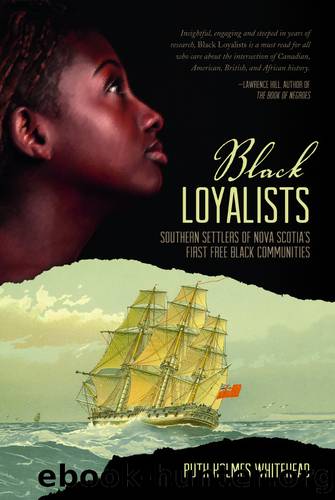Black Loyalists by Ruth Holmes Whithead

Author:Ruth Holmes Whithead
Language: eng
Format: epub
Publisher: Nimbus Publishing
Published: 2013-07-16T00:00:00+00:00
Chapter Six
WAR'S END, 1781â1783
1781
The war was about to explode into what would prove to be the final major siege for control of America. General Cornwallis left Wilmington, North Carolina, marching north on April 25, followed by countless Black Loyalists from Georgia and the Carolinas. He crossed into Virginia toward the end of May. Well aware of the apparent avenue for escape that the British Army provided, Virginian slaves began fleeing to the British by the thousands. After the war, Thomas Jefferson was to speculate that over thirty thousand black people had run for freedom.271
In early April of 1781, Virginian Richard Henry Lee complained to Samuel Adams that the British were making constant forays from ships in Chesapeake Bay, snatching foods, livestock, and slaves from coastal plantations. By mid-month, he was explaining to Thomas Jefferson that Virginia could expect raids on a much larger scale.272 Little did he know just how bad the situation was to become. By May 20, Cornwallis had reached Petersburg, Virginia, joining General Benedict Arnoldâs forces. On June 4, Richard Henry Lee was writing to his brother Arthur, âTis said that 2 or 3000 negroes march in their train, every kind of Stock which they cannot remove they destroy â eating up the green wheat & by destroying of the fences, expose to destruction the other growing grains.â By July, he was telling his brother William, âYour neighbors Colo Taliaferro & Colo Travis lost every slave they had in the world, and Mr. Paradise has lost all his but one.â Wrote Lee in despair, âCornwallis is the Scourge.â273
The British general was using Black Loyalists and captured slaves to swell his baggage train, then sweeping this train across Virginia like a scythe. They were becoming one of his weapons, by virtue of their numbers alone, and the simple fact that they had to eat. Johann Ewald is one of the few eyewitnesses to have recorded a lengthy description of the blacks following Cornwallis:
Every officer had four to six horses, and three or four Negroes, as well as one or two Negresses for cook and maid. Every soldierâs woman was mounted and also had a Negro and Negress on horseback for her servants. Each squad had one or two horses and Negroes, and every non-commissioned officer had two horses and one Negro. Yes, indeed, I can testify that every soldier had his Negro, who carried his provisions and bundles. This multitude always hunted at a gallop, and behind the baggage followed well over four thousand Negroes of both sexes and all ages. Any place this horde approached was eaten clean, like an acre invaded by a swarm of locusts. Where all these people lived was a riddle to me.274
Ewald had no illusions about why the British had welcomed Black Loyalists into their fold: âThese people were given their freedom by the army because it was actually thought this would punish the rich, rebellious-minded inhabitants of Carolina and Virginia.â275
Although some of these Black Loyalists had followed the army from Georgia and the Carolinas, their numbers increased exponentially with the addition of the Virginia blacks.
Download
This site does not store any files on its server. We only index and link to content provided by other sites. Please contact the content providers to delete copyright contents if any and email us, we'll remove relevant links or contents immediately.
| 19th Century | 20th Century |
| Exploration | First Nations |
| Founding | Pre-Confederation |
| Province & Local | War of 1812 |
Cat's cradle by Kurt Vonnegut(15152)
Pimp by Iceberg Slim(14318)
4 3 2 1: A Novel by Paul Auster(12263)
Underground: A Human History of the Worlds Beneath Our Feet by Will Hunt(11997)
The Radium Girls by Kate Moore(11899)
Wiseguy by Nicholas Pileggi(5647)
Perfect Rhythm by Jae(5305)
American History Stories, Volume III (Yesterday's Classics) by Pratt Mara L(5239)
The Fire Next Time by James Baldwin(5224)
Paper Towns by Green John(5065)
Pale Blue Dot by Carl Sagan(4886)
A Higher Loyalty: Truth, Lies, and Leadership by James Comey(4822)
The Mayflower and the Pilgrims' New World by Nathaniel Philbrick(4403)
The Doomsday Machine by Daniel Ellsberg(4397)
Killers of the Flower Moon: The Osage Murders and the Birth of the FBI by David Grann(4368)
The Sympathizer by Viet Thanh Nguyen(4287)
Too Much and Not the Mood by Durga Chew-Bose(4254)
The Borden Murders by Sarah Miller(4216)
Sticky Fingers by Joe Hagan(4086)
